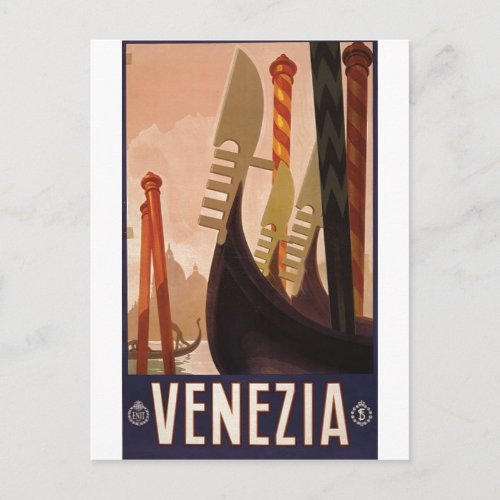Venezia travel poster 1920 Venice, Italy Postcard



Together with Padua, the city is included in the Padua-Venice Metropolitan Area (population 1,600,000). The city historically was the capital of an independent nation. Venice has been known as the "La Dominante", "Serenissima", "Queen of the Adriatic", "City of Water", "City of Bridges" and "City of Canals". Luigi Barzini, writing in The New York Times, described it as "undoubtedly the most beautiful city built by man". Venice has also been described by the Times Online as being one of Europe's most romantic cities. The city stretches across 118 small islands in the marshy Venetian Lagoon along the Adriatic Sea in northeast Italy. The saltwater lagoon stretches along the shoreline between the mouths of the Po (south) and the Piave (north) Rivers. The population estimate of 272,000 inhabitants includes the population of the whole Comune of Venezia; around 60,000 in the historic city of Venice (Centro storico); 176,000 in Terraferma (the Mainland), mostly in the large frazione of Mestre and Marghera; and 31,000 live on other islands in the lagoon. The Republic of Venice was a major maritime power during the Middle Ages and Renaissance, and a staging area for the Crusades and the Battle of Lepanto, as well as a very important center of commerce (especially silk, grain and spice trade) and art in the 13th century up to the end of the 17th century. Venice is also famous for its musical, particularly operatic, history, and its most famous son in this field is Antonio Vivaldi. While there are no historical records that deal directly with the origins of Venice, the available evidence has led several historians to agree that the original population of Venice comprised refugees from Roman cities such as Padua, Aquileia, Altino and Concordia (modern Portogruaro) who were fleeing successive waves of Germanic invasions and Huns.[4] Some late Roman sources reveal the existence of fishermen on the islands in the original marshy lagoons. They were referred to as incolae lacunae (lagoon dwellers). Beginning in 166-168, the Quadi and Marcomanni destroyed the main center in the area, the current Oderzo. The Roman defences were again overthrown in the early 5th century by the Visigoths and, some 50 years later, by the Huns led by Attila. The last and most enduring irruption was that of the Lombards in 568, leaving the Eastern Roman Empire a small strip of coast in the current Veneto, and the main administrative and religious entities were therefore transferred to this remaining dominion. New ports were built, including those at Malamocco and Torcello in the Venetian lagoon. The Byzantine domination of central and northern Italy was subsequently largely eliminated by the conquest of the Exarchate of Ravenna in 751 by Aistulf. During this period, the seat of the local Byzantine governor (the "duke/dux", later "doge") was situated in Malamocco. Settlement on the islands in the lagoon probably increased in correspondence with the Lombard conquest of the Byzantine territories. In 775-776, the bishopric seat of Olivolo (Helipolis) was created. During the reign of duke Agnello Particiaco (811-827) the ducal seat was moved from Malamocco to the highly protected Rialto (Rivoalto, "High Shore") island, the current location of Venice. The monastery of St. Zachary and the first ducal palace and basilica of St. Mark, as well as a walled defense (civitatis murus) between Olivolo and Rialto were subsequently built here. Winged lions which may be seen in Venice are a symbol for St. Mark. In 828, the new city's prestige was raised by the acquisition of the claimed relics of St. Mark the Evangelist from Alexandria, which were placed in the new basilica. The patriarchal seat was also moved to Rialto. As the community continued to develop and as Byzantine power waned, it led to the growth of autonomy and eventual independence. Venice became Austrian territory when Napoleon signed the Treaty of Campo Formio on 12 October 1797. The Austrians took control of the city on 18 January 1798. It was taken from Austria by the Treaty of Pressburg in 1805 and became part of Napoleon's Kingdom of Italy, but was returned to Austria following Napoleon's defeat in 1814, when it became part of the Austrian-held Kingdom of Lombardy-Venetia. In 1848-1849 a revolt briefly reestablished the Venetian Republic under Daniele Manin. In 1866, following the Third Italian War of Independence, Venice, along with the rest of the Veneto, became part of the newly created Kingdom of Italy. During the Second World War, the city was largely free from attack, the only aggressive effort of note being Operation Bowler, a precision strike on the German naval operations there in 1945. Venice was finally liberated by New Zealand troops under Freyberg on 29 April 1945.


